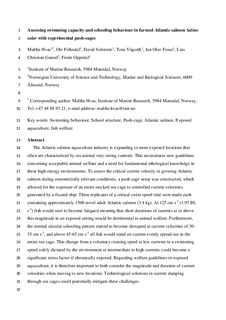| dc.contributor.author | Hvas, Malthe | |
| dc.contributor.author | Folkedal, Ole | |
| dc.contributor.author | Solstorm, David | |
| dc.contributor.author | Vågseth, Tone | |
| dc.contributor.author | Fosse, Jan Olav | |
| dc.contributor.author | Gansel, Lars Christian | |
| dc.contributor.author | Oppedal, Frode | |
| dc.date.accessioned | 2017-12-08T10:15:47Z | |
| dc.date.available | 2017-12-08T10:15:47Z | |
| dc.date.created | 2017-08-02T11:17:53Z | |
| dc.date.issued | 2017 | |
| dc.identifier.citation | Aquaculture. 2017, 473 423-429. | nb_NO |
| dc.identifier.issn | 0044-8486 | |
| dc.identifier.uri | http://hdl.handle.net/11250/2469726 | |
| dc.description.abstract | The Atlantic salmon aquaculture industry is expanding to more exposed locations that often are characterized by occasional very strong currents. This necessitates new guidelines concerning acceptable animal welfare and a need for fundamental ethological knowledge in these high energy environments. To assess the critical current velocity in growing Atlantic salmon during commercially relevant conditions, a push-cage setup was constructed, which allowed for the exposure of an entire stocked sea cage to controlled current velocities generated by a fixated ship. Three replicates of a critical swim speed trial were made each containing approximately 1500 novel adult Atlantic salmon (3.4 kg). At 125 cm s− 1 (1.97 BL s− 1) fish would start to become fatigued meaning that short durations of currents at or above this magnitude in an exposed setting would be detrimental to animal welfare. Furthermore, the normal circular schooling pattern started to become disrupted at current velocities of 30–35 cm s− 1, and above 45–65 cm s− 1 all fish would stand on current evenly spread out in the entire sea cage. This change from a voluntary cruising speed at low currents to a swimming speed solely dictated by the environment at intermediate to high currents could become a significant stress factor if chronically exposed. Regarding welfare guidelines in exposed aquaculture, it is therefore important to both consider the magnitude and duration of current velocities when moving to new locations. Technological solutions in current damping through sea cages could potentially mitigate these challenges. | nb_NO |
| dc.language.iso | eng | nb_NO |
| dc.publisher | Elsevier | nb_NO |
| dc.title | Assessing swimming capacity and schooling behaviour in farmed Atlantic salmon Salmo salar with experimental push-cages | nb_NO |
| dc.type | Journal article | nb_NO |
| dc.type | Peer reviewed | nb_NO |
| dc.description.version | submittedVersion | nb_NO |
| dc.source.pagenumber | 423-429 | nb_NO |
| dc.source.volume | 473 | nb_NO |
| dc.source.journal | Aquaculture | nb_NO |
| dc.identifier.doi | 10.1016/j.aquaculture.2017.03.013 | |
| dc.identifier.cristin | 1483785 | |
| dc.relation.project | Norges forskningsråd: 237790 | nb_NO |
| dc.relation.project | Norges forskningsråd: 841005 | nb_NO |
| dc.relation.project | Norges forskningsråd: 267800 | nb_NO |
| dc.description.localcode | This is a submitted manuscript of an article published by Aquaculture in Physical Review B, 7 March 2017. | nb_NO |
| cristin.unitcode | 194,66,45,0 | |
| cristin.unitname | Institutt for biologiske fag Ålesund | |
| cristin.ispublished | true | |
| cristin.fulltext | preprint | |
| cristin.qualitycode | 1 | |
